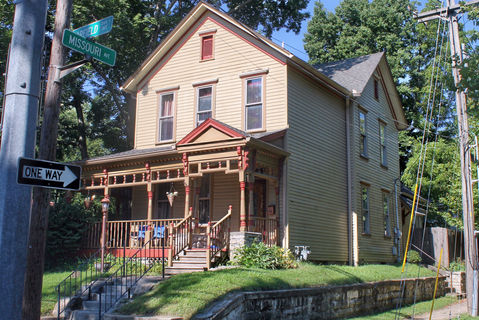
The years following the Civil War and the westward movement in some measure had a direct impact on what would later become Pendleton Heights. The population of Kansas City more than doubled between 1870 and 1880 which resulted in the demand for city leaders to expand the borders. Early landowners in the northeastern area began to see the potential for their own economic ventures and, as a result, marketed the area to “men of stature”. Large residential lots resting high above the City appealed to the high-level, affluent businessmen which included Jemuel C. Gates and William W. Kendall who built lavish homes on Independence Avenue (later to become Independence Boulevard) during this building boom. Elaborate mansions and luxury apartments were constructed throughout the new neighborhood. In summary, real estate was selling at high prices as compared to the rest of Kansas City.
In 1885, the cable railway was introduced by Gillham and Smith. At this time, land was still plentiful and Willard Winner began to sell land in small plats which were divided into smaller lots than those sold to the wealthy. During this time, the Queen Anne architectural style and adaption of such was popular by virtue of housing plan catalogs and architectural publications. Prime examples of this style are the Charles B. Leach residence at 308 Garfield Avenue and the Phillip E. Chappell home at 1836 Pendleton Avenue.
1900 brought about a variety of style changes in Pendleton Heights. A medieval castle was built by noted oculist Flavel B. Tiffany along with symmetrical Prairie Style residences with low pitches, hipped roofs and exaggerated eaves. This evolution of architectural styles made their entry and established a new trend. By this time, Pendleton Heights had seen the end of the high-end homes, and the focus became filling in pockets of undeveloped lots with more modest housing. Smaller one-story homes were built next to the more elaborate three-story mansions made of brick or stone.
As soldiers returned from World War I, the City’s population continued to increase and a housing shortage ensued. The 1920s began a shift of the older homes being left by a gentry that began moving to developments farther south to Kansas City’s newer subdivisions. As working-class and middle-class families began replacing the earlier more affluent homeowners, social changes accelerated by the Great Depression led to many Italian immigrants relocating here from the old North End to Pendleton Heights. Again, housing was at a premium. Many of the old stately homes were divided into multiple apartments or razed to accommodate more modest housing. Many houses were allowed to deteriorate beyond repair and were demolished without regard to their history or their ability to be rehabilitated.
Beginning in the 1970s, a new group of urban pioneers began to see the historical value and the quality construction of the area’s homes. They welcomed the personal commitment of a labor of love as well as financial dedication to return the remaining homes to their original grandeur and beauty. The trend continued and today Pendleton Heights has a diverse social and economic culture. Much of the fine early housing stock remains standing and has been or is in the process of being lovingly restored. Continued efforts are made to create a unity of culture and beliefs through its schools and churches. Groups of neighbors are proud to join forces to advance together for the betterment of Pendleton Heights.
























